Analysis of Singapore's Economy: Unemployment, Inflation, and GDP
VerifiedAdded on 2022/10/15
|11
|2527
|206
Report
AI Summary
This report provides a comprehensive analysis of the Singapore economy, focusing on key economic indicators such as Gross Domestic Product (GDP), inflation, and unemployment rates. It examines the performance of the Singaporean economy, highlighting trends and fluctuations in GDP growth from 2008 to 2018 and discusses the government's efforts to enhance GDP through fiscal policies and ease of doing business. The report delves into the labor market, analyzing unemployment trends, including cyclical, structural, frictional, seasonal, disguised, and voluntary unemployment, and the government's interventions to improve the situation. Furthermore, it investigates price level analysis, the causes of inflation, and the government's monetary, supply-side, and fiscal policies aimed at maintaining price stability. The conclusion summarizes the key findings, emphasizing Singapore's strong economic conditions supported by effective government policies and its adaptability to changing circumstances.
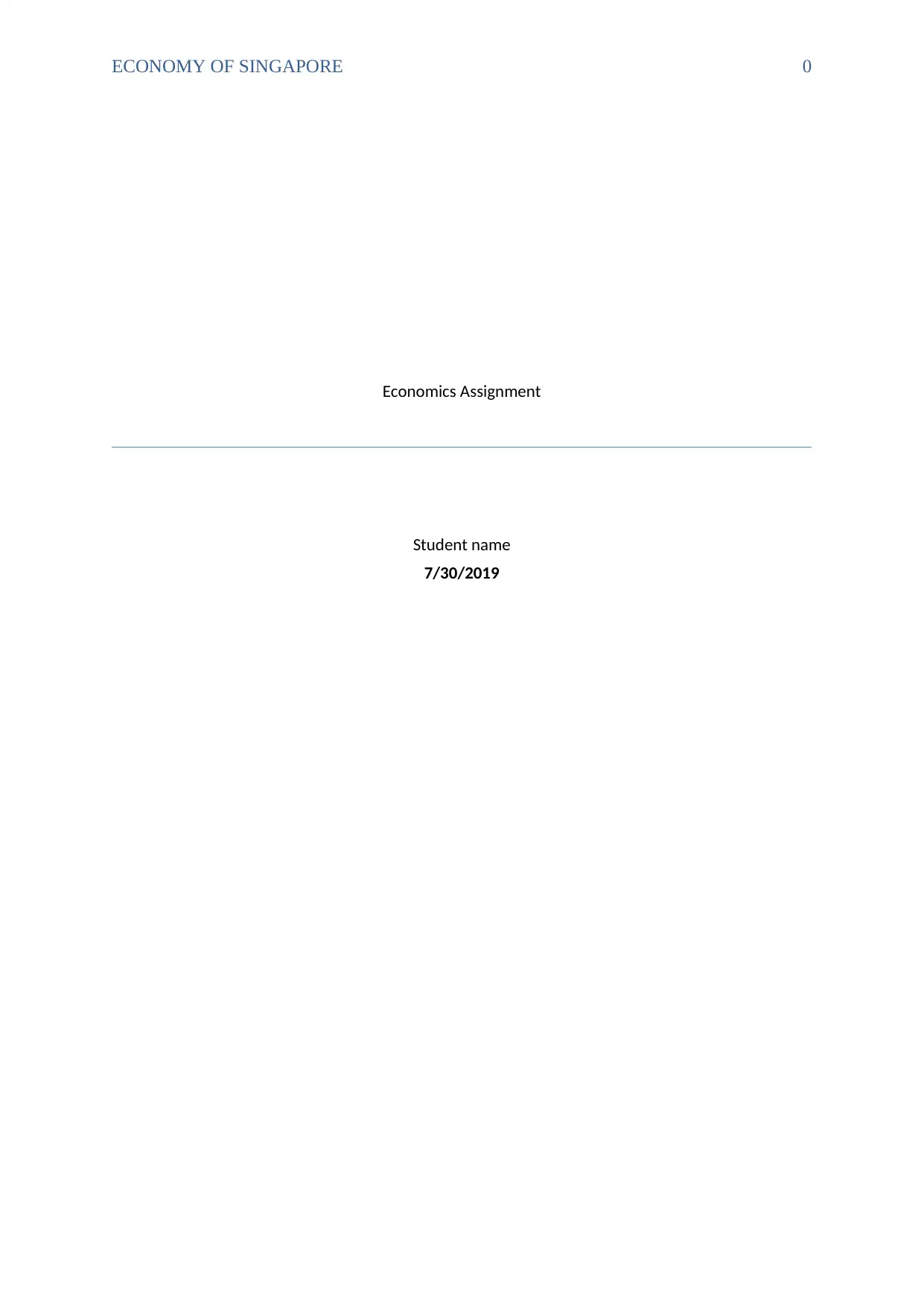
ECONOMY OF SINGAPORE 0
Economics Assignment
Student name
7/30/2019
Economics Assignment
Student name
7/30/2019
Paraphrase This Document
Need a fresh take? Get an instant paraphrase of this document with our AI Paraphraser

DISCUSSION ON UNEMPLOYMENT, INFLATION AND GDP
1
Contents
Introduction:...............................................................................................................................2
Performance Analysis:...............................................................................................................3
Labour Market Analysis:............................................................................................................4
Price level analysis:....................................................................................................................6
Conclusion:................................................................................................................................8
Bibliography.............................................................................................................................10
1
Contents
Introduction:...............................................................................................................................2
Performance Analysis:...............................................................................................................3
Labour Market Analysis:............................................................................................................4
Price level analysis:....................................................................................................................6
Conclusion:................................................................................................................................8
Bibliography.............................................................................................................................10
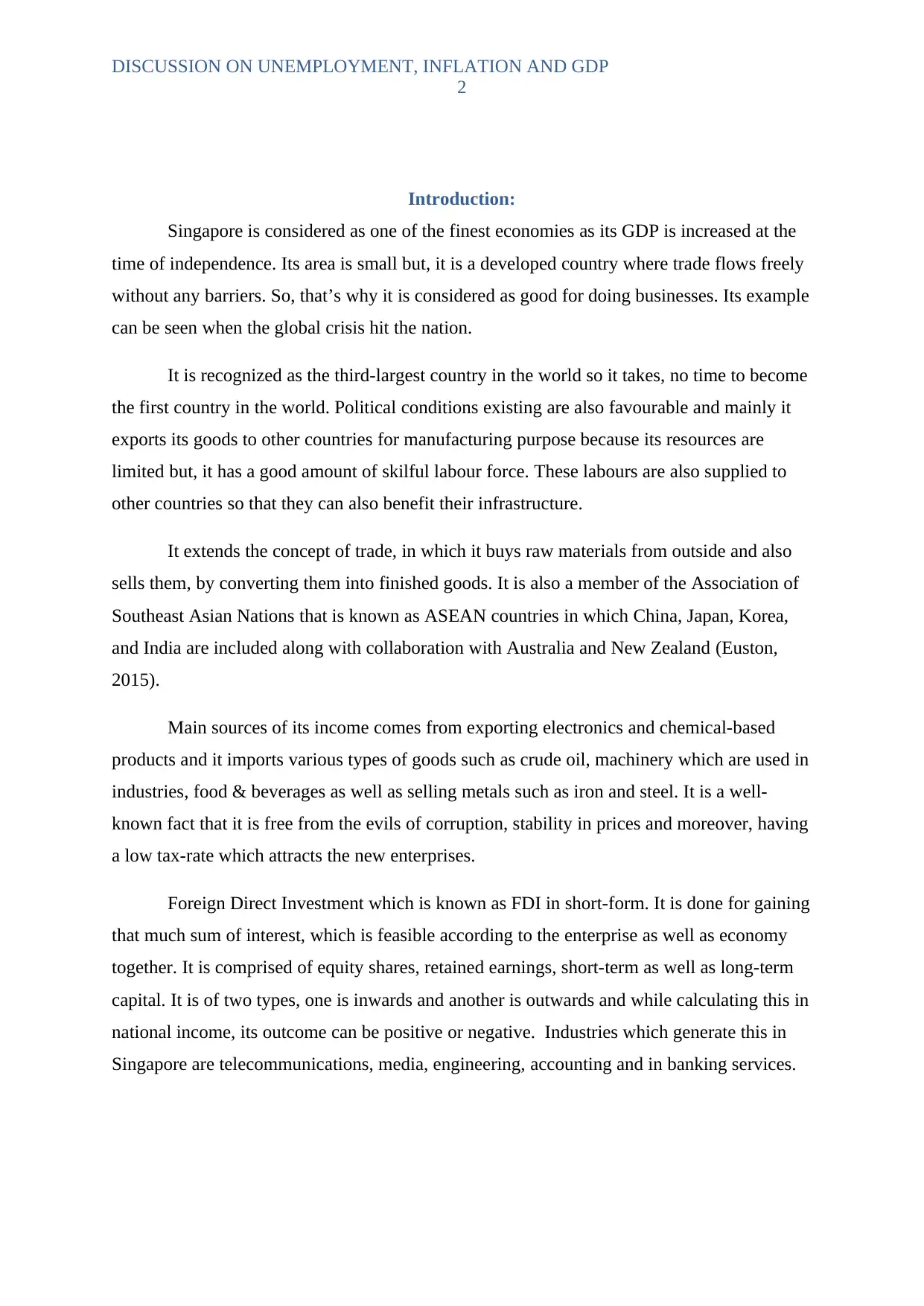
DISCUSSION ON UNEMPLOYMENT, INFLATION AND GDP
2
Introduction:
Singapore is considered as one of the finest economies as its GDP is increased at the
time of independence. Its area is small but, it is a developed country where trade flows freely
without any barriers. So, that’s why it is considered as good for doing businesses. Its example
can be seen when the global crisis hit the nation.
It is recognized as the third-largest country in the world so it takes, no time to become
the first country in the world. Political conditions existing are also favourable and mainly it
exports its goods to other countries for manufacturing purpose because its resources are
limited but, it has a good amount of skilful labour force. These labours are also supplied to
other countries so that they can also benefit their infrastructure.
It extends the concept of trade, in which it buys raw materials from outside and also
sells them, by converting them into finished goods. It is also a member of the Association of
Southeast Asian Nations that is known as ASEAN countries in which China, Japan, Korea,
and India are included along with collaboration with Australia and New Zealand (Euston,
2015).
Main sources of its income comes from exporting electronics and chemical-based
products and it imports various types of goods such as crude oil, machinery which are used in
industries, food & beverages as well as selling metals such as iron and steel. It is a well-
known fact that it is free from the evils of corruption, stability in prices and moreover, having
a low tax-rate which attracts the new enterprises.
Foreign Direct Investment which is known as FDI in short-form. It is done for gaining
that much sum of interest, which is feasible according to the enterprise as well as economy
together. It is comprised of equity shares, retained earnings, short-term as well as long-term
capital. It is of two types, one is inwards and another is outwards and while calculating this in
national income, its outcome can be positive or negative. Industries which generate this in
Singapore are telecommunications, media, engineering, accounting and in banking services.
2
Introduction:
Singapore is considered as one of the finest economies as its GDP is increased at the
time of independence. Its area is small but, it is a developed country where trade flows freely
without any barriers. So, that’s why it is considered as good for doing businesses. Its example
can be seen when the global crisis hit the nation.
It is recognized as the third-largest country in the world so it takes, no time to become
the first country in the world. Political conditions existing are also favourable and mainly it
exports its goods to other countries for manufacturing purpose because its resources are
limited but, it has a good amount of skilful labour force. These labours are also supplied to
other countries so that they can also benefit their infrastructure.
It extends the concept of trade, in which it buys raw materials from outside and also
sells them, by converting them into finished goods. It is also a member of the Association of
Southeast Asian Nations that is known as ASEAN countries in which China, Japan, Korea,
and India are included along with collaboration with Australia and New Zealand (Euston,
2015).
Main sources of its income comes from exporting electronics and chemical-based
products and it imports various types of goods such as crude oil, machinery which are used in
industries, food & beverages as well as selling metals such as iron and steel. It is a well-
known fact that it is free from the evils of corruption, stability in prices and moreover, having
a low tax-rate which attracts the new enterprises.
Foreign Direct Investment which is known as FDI in short-form. It is done for gaining
that much sum of interest, which is feasible according to the enterprise as well as economy
together. It is comprised of equity shares, retained earnings, short-term as well as long-term
capital. It is of two types, one is inwards and another is outwards and while calculating this in
national income, its outcome can be positive or negative. Industries which generate this in
Singapore are telecommunications, media, engineering, accounting and in banking services.
⊘ This is a preview!⊘
Do you want full access?
Subscribe today to unlock all pages.

Trusted by 1+ million students worldwide
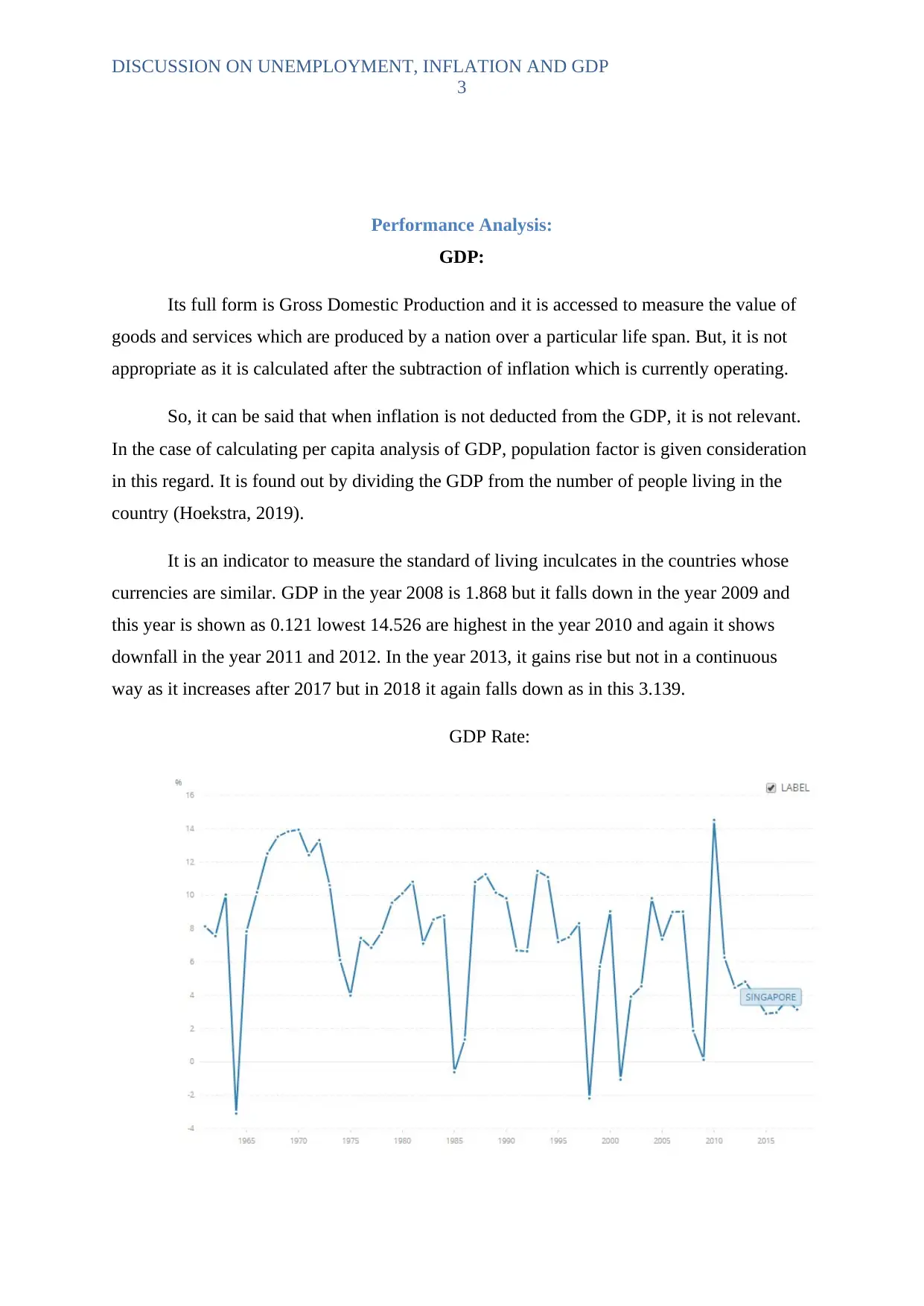
DISCUSSION ON UNEMPLOYMENT, INFLATION AND GDP
3
Performance Analysis:
GDP:
Its full form is Gross Domestic Production and it is accessed to measure the value of
goods and services which are produced by a nation over a particular life span. But, it is not
appropriate as it is calculated after the subtraction of inflation which is currently operating.
So, it can be said that when inflation is not deducted from the GDP, it is not relevant.
In the case of calculating per capita analysis of GDP, population factor is given consideration
in this regard. It is found out by dividing the GDP from the number of people living in the
country (Hoekstra, 2019).
It is an indicator to measure the standard of living inculcates in the countries whose
currencies are similar. GDP in the year 2008 is 1.868 but it falls down in the year 2009 and
this year is shown as 0.121 lowest 14.526 are highest in the year 2010 and again it shows
downfall in the year 2011 and 2012. In the year 2013, it gains rise but not in a continuous
way as it increases after 2017 but in 2018 it again falls down as in this 3.139.
GDP Rate:
3
Performance Analysis:
GDP:
Its full form is Gross Domestic Production and it is accessed to measure the value of
goods and services which are produced by a nation over a particular life span. But, it is not
appropriate as it is calculated after the subtraction of inflation which is currently operating.
So, it can be said that when inflation is not deducted from the GDP, it is not relevant.
In the case of calculating per capita analysis of GDP, population factor is given consideration
in this regard. It is found out by dividing the GDP from the number of people living in the
country (Hoekstra, 2019).
It is an indicator to measure the standard of living inculcates in the countries whose
currencies are similar. GDP in the year 2008 is 1.868 but it falls down in the year 2009 and
this year is shown as 0.121 lowest 14.526 are highest in the year 2010 and again it shows
downfall in the year 2011 and 2012. In the year 2013, it gains rise but not in a continuous
way as it increases after 2017 but in 2018 it again falls down as in this 3.139.
GDP Rate:
Paraphrase This Document
Need a fresh take? Get an instant paraphrase of this document with our AI Paraphraser
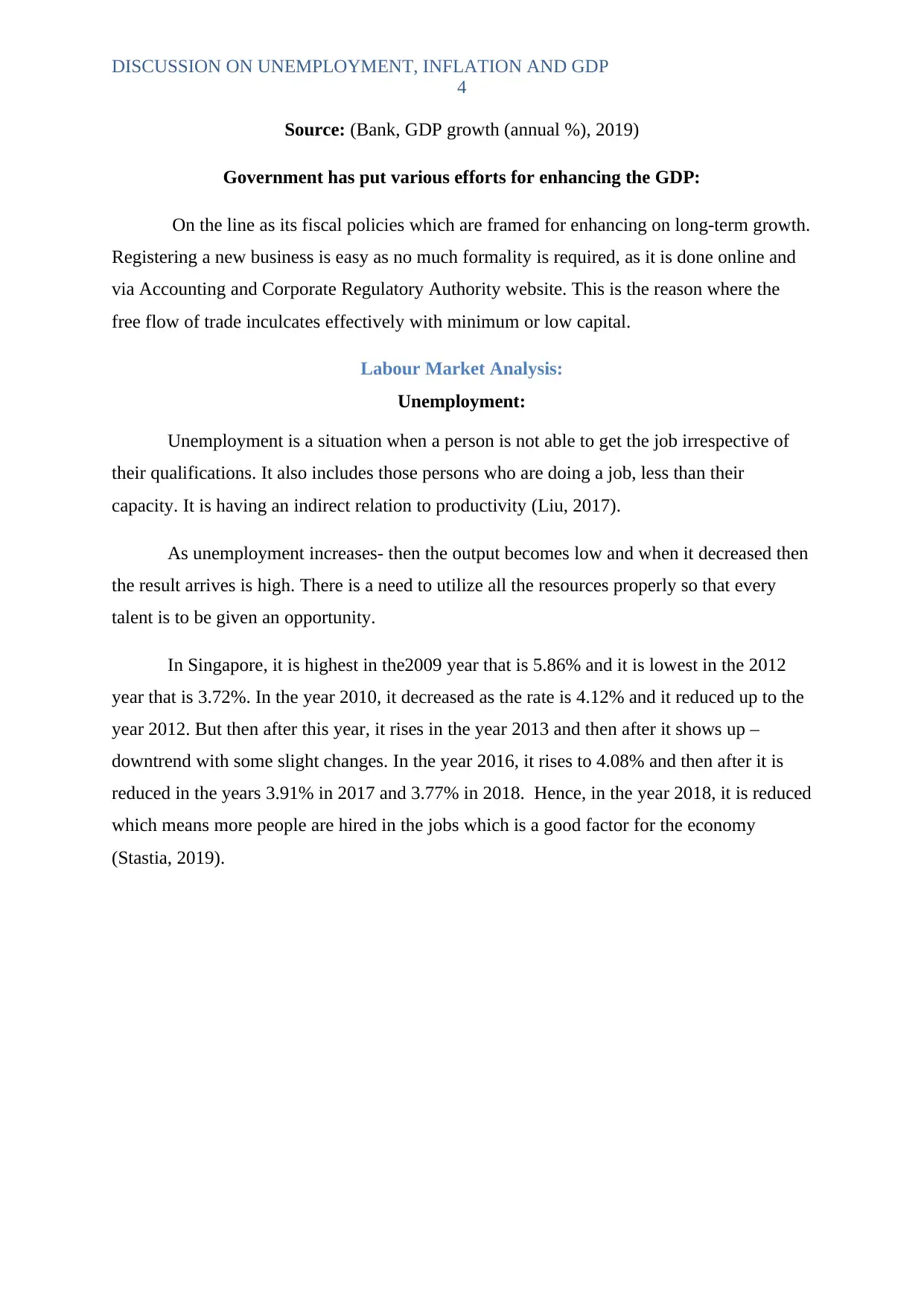
DISCUSSION ON UNEMPLOYMENT, INFLATION AND GDP
4
Source: (Bank, GDP growth (annual %), 2019)
Government has put various efforts for enhancing the GDP:
On the line as its fiscal policies which are framed for enhancing on long-term growth.
Registering a new business is easy as no much formality is required, as it is done online and
via Accounting and Corporate Regulatory Authority website. This is the reason where the
free flow of trade inculcates effectively with minimum or low capital.
Labour Market Analysis:
Unemployment:
Unemployment is a situation when a person is not able to get the job irrespective of
their qualifications. It also includes those persons who are doing a job, less than their
capacity. It is having an indirect relation to productivity (Liu, 2017).
As unemployment increases- then the output becomes low and when it decreased then
the result arrives is high. There is a need to utilize all the resources properly so that every
talent is to be given an opportunity.
In Singapore, it is highest in the2009 year that is 5.86% and it is lowest in the 2012
year that is 3.72%. In the year 2010, it decreased as the rate is 4.12% and it reduced up to the
year 2012. But then after this year, it rises in the year 2013 and then after it shows up –
downtrend with some slight changes. In the year 2016, it rises to 4.08% and then after it is
reduced in the years 3.91% in 2017 and 3.77% in 2018. Hence, in the year 2018, it is reduced
which means more people are hired in the jobs which is a good factor for the economy
(Stastia, 2019).
4
Source: (Bank, GDP growth (annual %), 2019)
Government has put various efforts for enhancing the GDP:
On the line as its fiscal policies which are framed for enhancing on long-term growth.
Registering a new business is easy as no much formality is required, as it is done online and
via Accounting and Corporate Regulatory Authority website. This is the reason where the
free flow of trade inculcates effectively with minimum or low capital.
Labour Market Analysis:
Unemployment:
Unemployment is a situation when a person is not able to get the job irrespective of
their qualifications. It also includes those persons who are doing a job, less than their
capacity. It is having an indirect relation to productivity (Liu, 2017).
As unemployment increases- then the output becomes low and when it decreased then
the result arrives is high. There is a need to utilize all the resources properly so that every
talent is to be given an opportunity.
In Singapore, it is highest in the2009 year that is 5.86% and it is lowest in the 2012
year that is 3.72%. In the year 2010, it decreased as the rate is 4.12% and it reduced up to the
year 2012. But then after this year, it rises in the year 2013 and then after it shows up –
downtrend with some slight changes. In the year 2016, it rises to 4.08% and then after it is
reduced in the years 3.91% in 2017 and 3.77% in 2018. Hence, in the year 2018, it is reduced
which means more people are hired in the jobs which is a good factor for the economy
(Stastia, 2019).

DISCUSSION ON UNEMPLOYMENT, INFLATION AND GDP
5
Source: (Stastia, 2019)
Types of unemployment:
a. Cyclical unemployment: It is created due to fluctuations which arouse in the
economy. It is concerned with the demand and supply part. It happens due to ups and
downs running in the economy.
b. Structural unemployment: It is because of the skills deprivation problem. It happens
mainly due to change in technology as the new technique requires the men who
specialize in it and not those who are not used to with this.
c. Frictional unemployment: It is the situation which happens when the person leaves
the current job in order to grasp the opportunity of newer job and the time from which
search of a job is made is treated as that situation. It is done because the individual is
unaware of the fact of employment opportunities are available in that place or not.
d. Seasonal unemployment: It is the employment which is based on seasons. At the end
of the particular season, they remain unemployed (LORIA, 2018).
e. Disguised unemployment: It is a situation where people are working more than
required so, remaining ones are unemployed. A popular example of this is in
5
Source: (Stastia, 2019)
Types of unemployment:
a. Cyclical unemployment: It is created due to fluctuations which arouse in the
economy. It is concerned with the demand and supply part. It happens due to ups and
downs running in the economy.
b. Structural unemployment: It is because of the skills deprivation problem. It happens
mainly due to change in technology as the new technique requires the men who
specialize in it and not those who are not used to with this.
c. Frictional unemployment: It is the situation which happens when the person leaves
the current job in order to grasp the opportunity of newer job and the time from which
search of a job is made is treated as that situation. It is done because the individual is
unaware of the fact of employment opportunities are available in that place or not.
d. Seasonal unemployment: It is the employment which is based on seasons. At the end
of the particular season, they remain unemployed (LORIA, 2018).
e. Disguised unemployment: It is a situation where people are working more than
required so, remaining ones are unemployed. A popular example of this is in
⊘ This is a preview!⊘
Do you want full access?
Subscribe today to unlock all pages.

Trusted by 1+ million students worldwide

DISCUSSION ON UNEMPLOYMENT, INFLATION AND GDP
6
agriculture. As in this, in a single field, 20 workers are working but actually required
is 10 maximum so, remaining ones must be shifted to industries so that they can also
become productive and not waste their own time.
f. Voluntary unemployment: It is that employment where the people willingly don’t
accept the offer because their expectations regarding their job not fulfilled.
In Singapore, unemployment is cyclical as the demand for job is mainly aroused from
exports and if demand at international level is stopped then automatically job also affects.
Frictional happens as there are fewer opportunities for labour in the market.
Structural arises because of globalization and technology factor as due to this many
employees leave their job but this should not happen as there is a requirement to possess
those necessary skills so that they can also become capable.
Steps were taken by the government to improve this situation faced in Singapore:
Make such fiscal policy in which dependence of domestic workers instead of relying
on foreign labours. It has been supported by training programs, so that they can also become
capable for the position and for encouraging the workers to learn, it gives subsidy.
It also provides funds for continuing education to those who are already in
employment but, it is essential for their growth. That’s why subsidy is given so that they can
also fulfil their dreams well. It also invests in the infrastructure of education so that a proper
learning environment is established.
Price level analysis:
It is a situation when prices got the rise and due to this, the value of purchasing power
for goods is decreased adversely in the market place. It shows how much price is increased
from the general price level (Donovan, 2015).
Inflation is not a good indicator, because at this time there is a shortage of goods
arisen and due to this, operations of the business affects. It is measured by GDP Deflator and
by a consumer price index. In this, GDP deflator is the broader index of inflation (AMADEO,
2019).
6
agriculture. As in this, in a single field, 20 workers are working but actually required
is 10 maximum so, remaining ones must be shifted to industries so that they can also
become productive and not waste their own time.
f. Voluntary unemployment: It is that employment where the people willingly don’t
accept the offer because their expectations regarding their job not fulfilled.
In Singapore, unemployment is cyclical as the demand for job is mainly aroused from
exports and if demand at international level is stopped then automatically job also affects.
Frictional happens as there are fewer opportunities for labour in the market.
Structural arises because of globalization and technology factor as due to this many
employees leave their job but this should not happen as there is a requirement to possess
those necessary skills so that they can also become capable.
Steps were taken by the government to improve this situation faced in Singapore:
Make such fiscal policy in which dependence of domestic workers instead of relying
on foreign labours. It has been supported by training programs, so that they can also become
capable for the position and for encouraging the workers to learn, it gives subsidy.
It also provides funds for continuing education to those who are already in
employment but, it is essential for their growth. That’s why subsidy is given so that they can
also fulfil their dreams well. It also invests in the infrastructure of education so that a proper
learning environment is established.
Price level analysis:
It is a situation when prices got the rise and due to this, the value of purchasing power
for goods is decreased adversely in the market place. It shows how much price is increased
from the general price level (Donovan, 2015).
Inflation is not a good indicator, because at this time there is a shortage of goods
arisen and due to this, operations of the business affects. It is measured by GDP Deflator and
by a consumer price index. In this, GDP deflator is the broader index of inflation (AMADEO,
2019).
Paraphrase This Document
Need a fresh take? Get an instant paraphrase of this document with our AI Paraphraser
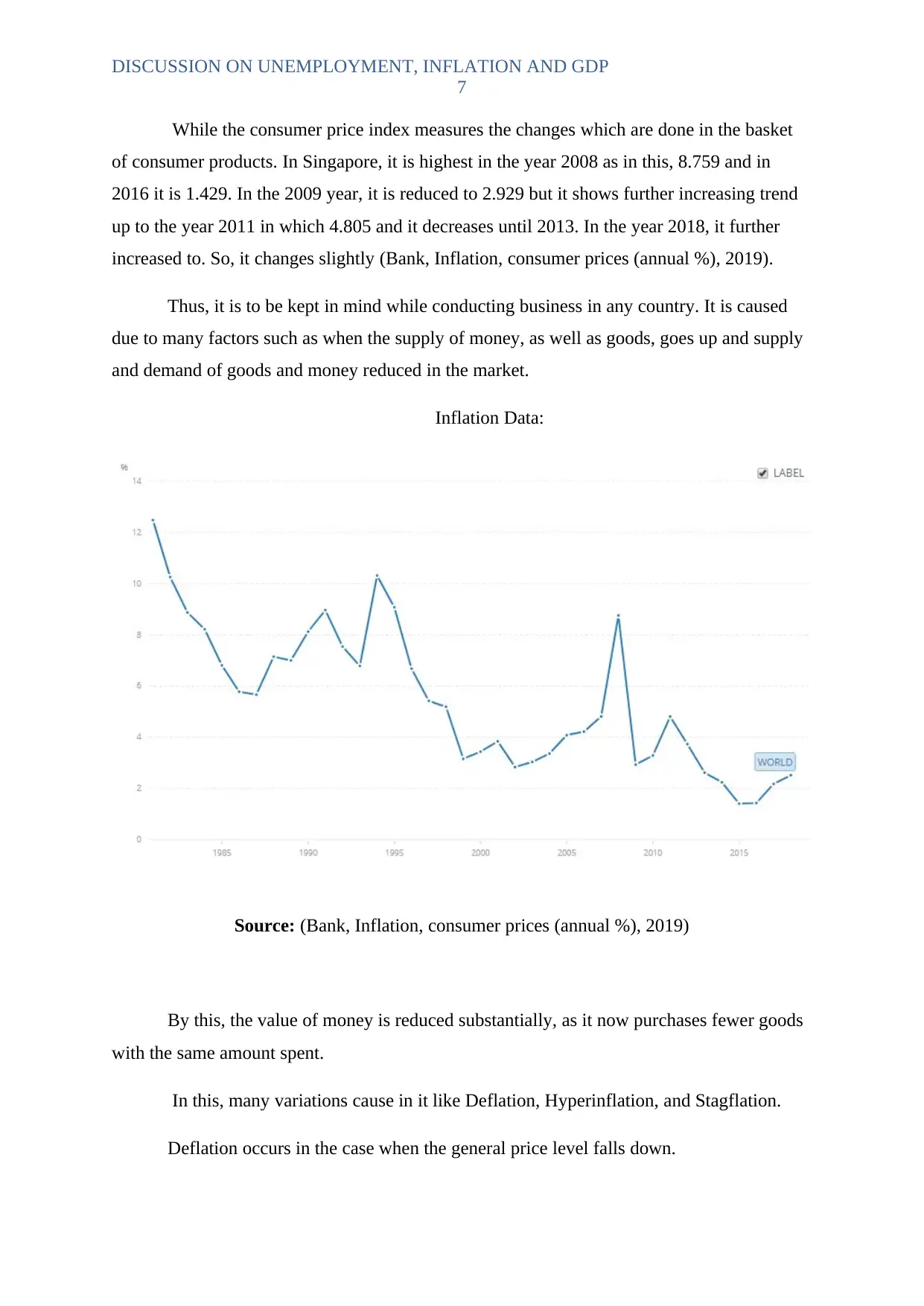
DISCUSSION ON UNEMPLOYMENT, INFLATION AND GDP
7
While the consumer price index measures the changes which are done in the basket
of consumer products. In Singapore, it is highest in the year 2008 as in this, 8.759 and in
2016 it is 1.429. In the 2009 year, it is reduced to 2.929 but it shows further increasing trend
up to the year 2011 in which 4.805 and it decreases until 2013. In the year 2018, it further
increased to. So, it changes slightly (Bank, Inflation, consumer prices (annual %), 2019).
Thus, it is to be kept in mind while conducting business in any country. It is caused
due to many factors such as when the supply of money, as well as goods, goes up and supply
and demand of goods and money reduced in the market.
Inflation Data:
Source: (Bank, Inflation, consumer prices (annual %), 2019)
By this, the value of money is reduced substantially, as it now purchases fewer goods
with the same amount spent.
In this, many variations cause in it like Deflation, Hyperinflation, and Stagflation.
Deflation occurs in the case when the general price level falls down.
7
While the consumer price index measures the changes which are done in the basket
of consumer products. In Singapore, it is highest in the year 2008 as in this, 8.759 and in
2016 it is 1.429. In the 2009 year, it is reduced to 2.929 but it shows further increasing trend
up to the year 2011 in which 4.805 and it decreases until 2013. In the year 2018, it further
increased to. So, it changes slightly (Bank, Inflation, consumer prices (annual %), 2019).
Thus, it is to be kept in mind while conducting business in any country. It is caused
due to many factors such as when the supply of money, as well as goods, goes up and supply
and demand of goods and money reduced in the market.
Inflation Data:
Source: (Bank, Inflation, consumer prices (annual %), 2019)
By this, the value of money is reduced substantially, as it now purchases fewer goods
with the same amount spent.
In this, many variations cause in it like Deflation, Hyperinflation, and Stagflation.
Deflation occurs in the case when the general price level falls down.
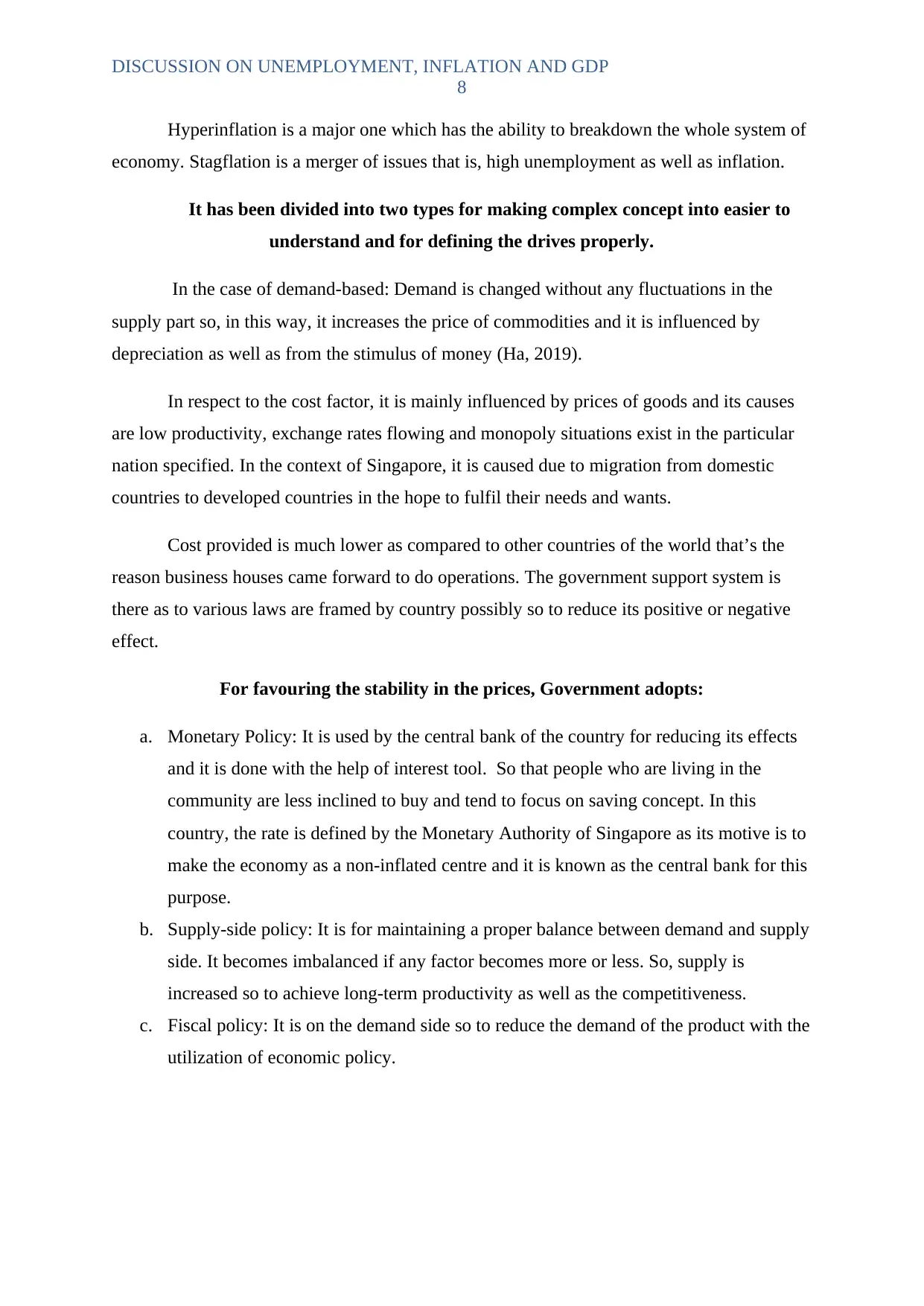
DISCUSSION ON UNEMPLOYMENT, INFLATION AND GDP
8
Hyperinflation is a major one which has the ability to breakdown the whole system of
economy. Stagflation is a merger of issues that is, high unemployment as well as inflation.
It has been divided into two types for making complex concept into easier to
understand and for defining the drives properly.
In the case of demand-based: Demand is changed without any fluctuations in the
supply part so, in this way, it increases the price of commodities and it is influenced by
depreciation as well as from the stimulus of money (Ha, 2019).
In respect to the cost factor, it is mainly influenced by prices of goods and its causes
are low productivity, exchange rates flowing and monopoly situations exist in the particular
nation specified. In the context of Singapore, it is caused due to migration from domestic
countries to developed countries in the hope to fulfil their needs and wants.
Cost provided is much lower as compared to other countries of the world that’s the
reason business houses came forward to do operations. The government support system is
there as to various laws are framed by country possibly so to reduce its positive or negative
effect.
For favouring the stability in the prices, Government adopts:
a. Monetary Policy: It is used by the central bank of the country for reducing its effects
and it is done with the help of interest tool. So that people who are living in the
community are less inclined to buy and tend to focus on saving concept. In this
country, the rate is defined by the Monetary Authority of Singapore as its motive is to
make the economy as a non-inflated centre and it is known as the central bank for this
purpose.
b. Supply-side policy: It is for maintaining a proper balance between demand and supply
side. It becomes imbalanced if any factor becomes more or less. So, supply is
increased so to achieve long-term productivity as well as the competitiveness.
c. Fiscal policy: It is on the demand side so to reduce the demand of the product with the
utilization of economic policy.
8
Hyperinflation is a major one which has the ability to breakdown the whole system of
economy. Stagflation is a merger of issues that is, high unemployment as well as inflation.
It has been divided into two types for making complex concept into easier to
understand and for defining the drives properly.
In the case of demand-based: Demand is changed without any fluctuations in the
supply part so, in this way, it increases the price of commodities and it is influenced by
depreciation as well as from the stimulus of money (Ha, 2019).
In respect to the cost factor, it is mainly influenced by prices of goods and its causes
are low productivity, exchange rates flowing and monopoly situations exist in the particular
nation specified. In the context of Singapore, it is caused due to migration from domestic
countries to developed countries in the hope to fulfil their needs and wants.
Cost provided is much lower as compared to other countries of the world that’s the
reason business houses came forward to do operations. The government support system is
there as to various laws are framed by country possibly so to reduce its positive or negative
effect.
For favouring the stability in the prices, Government adopts:
a. Monetary Policy: It is used by the central bank of the country for reducing its effects
and it is done with the help of interest tool. So that people who are living in the
community are less inclined to buy and tend to focus on saving concept. In this
country, the rate is defined by the Monetary Authority of Singapore as its motive is to
make the economy as a non-inflated centre and it is known as the central bank for this
purpose.
b. Supply-side policy: It is for maintaining a proper balance between demand and supply
side. It becomes imbalanced if any factor becomes more or less. So, supply is
increased so to achieve long-term productivity as well as the competitiveness.
c. Fiscal policy: It is on the demand side so to reduce the demand of the product with the
utilization of economic policy.
⊘ This is a preview!⊘
Do you want full access?
Subscribe today to unlock all pages.

Trusted by 1+ million students worldwide
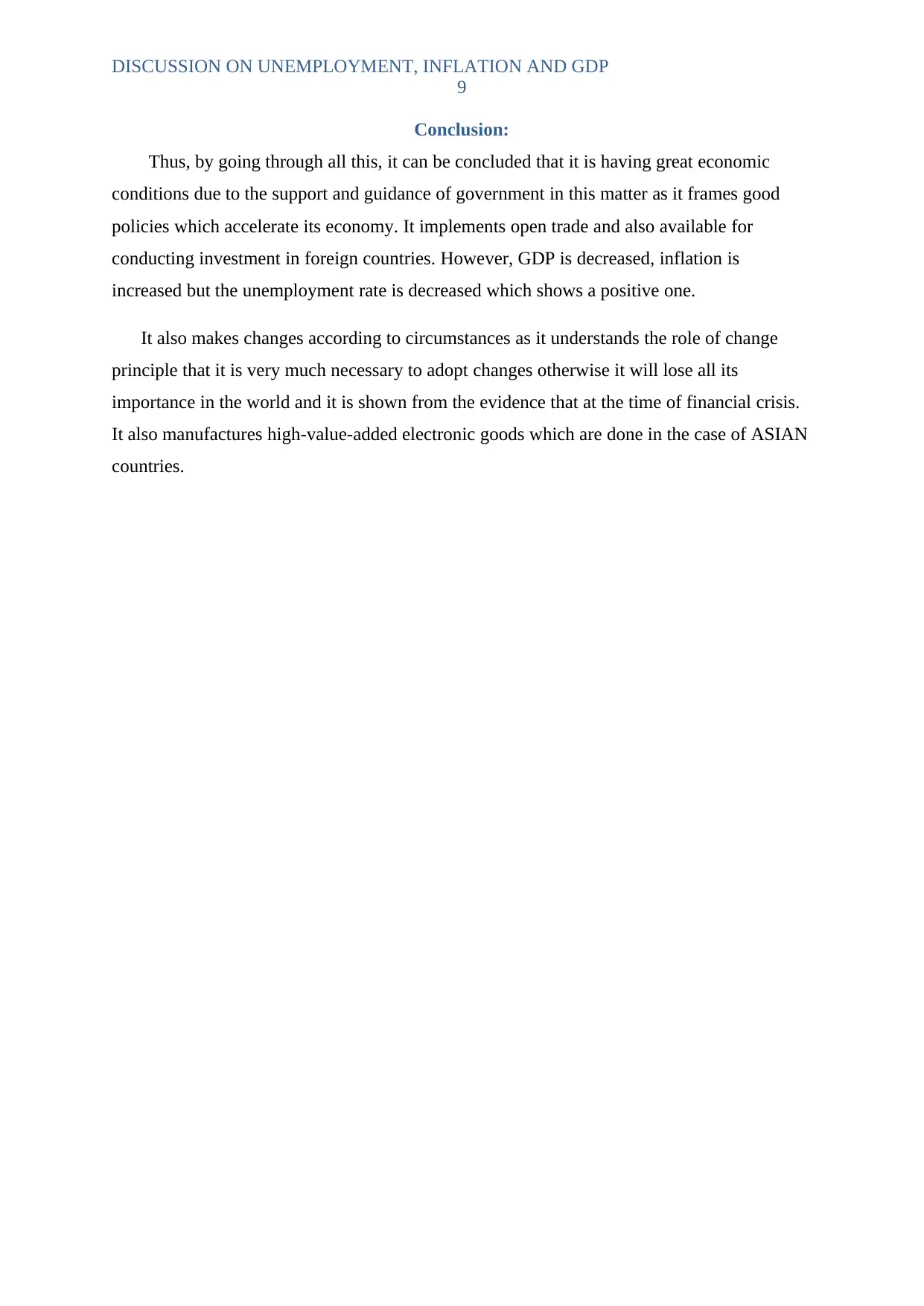
DISCUSSION ON UNEMPLOYMENT, INFLATION AND GDP
9
Conclusion:
Thus, by going through all this, it can be concluded that it is having great economic
conditions due to the support and guidance of government in this matter as it frames good
policies which accelerate its economy. It implements open trade and also available for
conducting investment in foreign countries. However, GDP is decreased, inflation is
increased but the unemployment rate is decreased which shows a positive one.
It also makes changes according to circumstances as it understands the role of change
principle that it is very much necessary to adopt changes otherwise it will lose all its
importance in the world and it is shown from the evidence that at the time of financial crisis.
It also manufactures high-value-added electronic goods which are done in the case of ASIAN
countries.
9
Conclusion:
Thus, by going through all this, it can be concluded that it is having great economic
conditions due to the support and guidance of government in this matter as it frames good
policies which accelerate its economy. It implements open trade and also available for
conducting investment in foreign countries. However, GDP is decreased, inflation is
increased but the unemployment rate is decreased which shows a positive one.
It also makes changes according to circumstances as it understands the role of change
principle that it is very much necessary to adopt changes otherwise it will lose all its
importance in the world and it is shown from the evidence that at the time of financial crisis.
It also manufactures high-value-added electronic goods which are done in the case of ASIAN
countries.
Paraphrase This Document
Need a fresh take? Get an instant paraphrase of this document with our AI Paraphraser
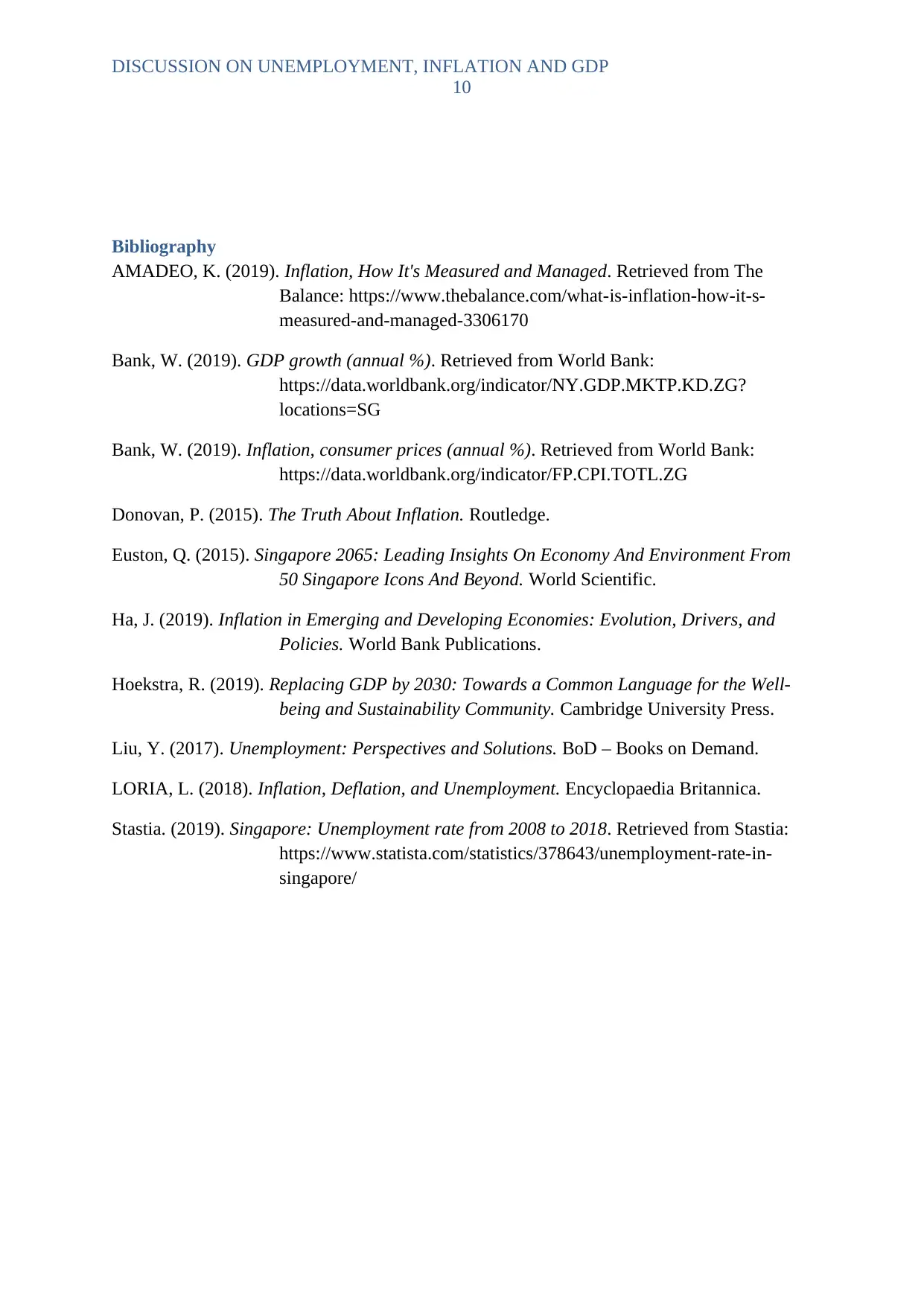
DISCUSSION ON UNEMPLOYMENT, INFLATION AND GDP
10
Bibliography
AMADEO, K. (2019). Inflation, How It's Measured and Managed. Retrieved from The
Balance: https://www.thebalance.com/what-is-inflation-how-it-s-
measured-and-managed-3306170
Bank, W. (2019). GDP growth (annual %). Retrieved from World Bank:
https://data.worldbank.org/indicator/NY.GDP.MKTP.KD.ZG?
locations=SG
Bank, W. (2019). Inflation, consumer prices (annual %). Retrieved from World Bank:
https://data.worldbank.org/indicator/FP.CPI.TOTL.ZG
Donovan, P. (2015). The Truth About Inflation. Routledge.
Euston, Q. (2015). Singapore 2065: Leading Insights On Economy And Environment From
50 Singapore Icons And Beyond. World Scientific.
Ha, J. (2019). Inflation in Emerging and Developing Economies: Evolution, Drivers, and
Policies. World Bank Publications.
Hoekstra, R. (2019). Replacing GDP by 2030: Towards a Common Language for the Well-
being and Sustainability Community. Cambridge University Press.
Liu, Y. (2017). Unemployment: Perspectives and Solutions. BoD – Books on Demand.
LORIA, L. (2018). Inflation, Deflation, and Unemployment. Encyclopaedia Britannica.
Stastia. (2019). Singapore: Unemployment rate from 2008 to 2018. Retrieved from Stastia:
https://www.statista.com/statistics/378643/unemployment-rate-in-
singapore/
10
Bibliography
AMADEO, K. (2019). Inflation, How It's Measured and Managed. Retrieved from The
Balance: https://www.thebalance.com/what-is-inflation-how-it-s-
measured-and-managed-3306170
Bank, W. (2019). GDP growth (annual %). Retrieved from World Bank:
https://data.worldbank.org/indicator/NY.GDP.MKTP.KD.ZG?
locations=SG
Bank, W. (2019). Inflation, consumer prices (annual %). Retrieved from World Bank:
https://data.worldbank.org/indicator/FP.CPI.TOTL.ZG
Donovan, P. (2015). The Truth About Inflation. Routledge.
Euston, Q. (2015). Singapore 2065: Leading Insights On Economy And Environment From
50 Singapore Icons And Beyond. World Scientific.
Ha, J. (2019). Inflation in Emerging and Developing Economies: Evolution, Drivers, and
Policies. World Bank Publications.
Hoekstra, R. (2019). Replacing GDP by 2030: Towards a Common Language for the Well-
being and Sustainability Community. Cambridge University Press.
Liu, Y. (2017). Unemployment: Perspectives and Solutions. BoD – Books on Demand.
LORIA, L. (2018). Inflation, Deflation, and Unemployment. Encyclopaedia Britannica.
Stastia. (2019). Singapore: Unemployment rate from 2008 to 2018. Retrieved from Stastia:
https://www.statista.com/statistics/378643/unemployment-rate-in-
singapore/
1 out of 11
Related Documents
Your All-in-One AI-Powered Toolkit for Academic Success.
+13062052269
info@desklib.com
Available 24*7 on WhatsApp / Email
![[object Object]](/_next/static/media/star-bottom.7253800d.svg)
Unlock your academic potential
Copyright © 2020–2025 A2Z Services. All Rights Reserved. Developed and managed by ZUCOL.




